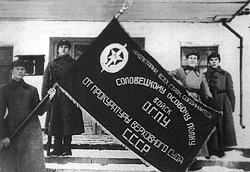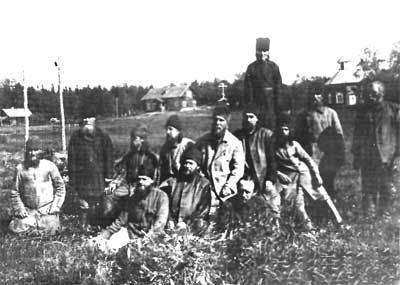 | ||
Solovki monastery
The Solovki prison camp (later Solovki prison), located on the Solovetsky Islands in the White Sea, was a large forced labor camp for political prisoners of Imperial Russia, and later the Soviet Union. During the Soviet era, as "Solovki Special Purpose Camp" it became a model where the NKVD developed and tested security measures, "living conditions", work production norms for prisoners, and different methods of repression. The exact number of prisoners who went through the camp during 1923–1939 is still unknown, but estimates range between tens and hundreds of thousands. It was the "mother of the GULAG" according to Aleksandr Solzhenitsyn. He estimated that in 1923 there were "no more than 3,000" prisoners, but that by 1930 the number had jumped to "about 50,000" with another 30,000 imprisoned at the nearby railroad transit point of Kem.
Contents
- Solovki monastery
- Tours tv com solovki prison camp
- History
- Notable prisoners
- Solovki camp in art and literature
- References

Tours tv com solovki prison camp
History

Historically, the Solovetsky Islands were the location of the famous Russian Orthodox Solovetsky Monastery complex, which repelled foreign attacks during the Time of Troubles, the Crimean War, and the Russian Civil War.

By Lenin's decree, the monastery buildings were turned into Solovetsky Lager' Osobogo Naznachenia (SLON), that is, the "Solovki Special Purpose Camp". The acronym of the camp name is a sullen word play for those who speak Russian: slon means "elephant". It was one of the first "corrective labor camps", a prototype of the Gulag system. In the beginning of 1924 sometimes the double name was used Severnye (Solovetskiye) Lagerya OGPU (Northern (Solvki) camps of OGPU).

In 1926 the Solovki camp was turned into a prison, partly because of the conditions which made escape near-impossible and partly because the monastery had been used as a political prison by the Russian imperial administration. The treatment of the prisoners attracted much criticism in Western Europe and the USA. After a thorough cleanup, the Soviet government sent the proletarian writer Maxim Gorky to the camp in an attempt to counter this criticism and he wrote a very favourable essay, which praised the beautiful nature of the islands. He is believed by some authors to have understood the real conditions, but the full facts remain a mystery.

During the early 1930s many of the prisoners from the camp worked on the notorious White Sea – Baltic Canal. From August 11, 1937, to December 24, 1938, more than 9500 victims of Soviet political repressions were executed by shooting and buried at nearby Sandarmokh. More than 1100 of these were from the Solovki camp.
The prison was closed in 1939 because the Second World War was imminent, while the camp was situated close to the border with Finland. The buildings were then transformed into a naval base. The navy cadet corps was deployed in the monastery buildings, one of the notable cadets was the future author Valentin Pikul.
The Orthodox Church reestablished the monastery in 1992, the year when the ensemble was included into UNESCO's World Heritage List. In 2015 human rights activists accused the authorities of "gradually removing all traces of the labor camp".
Notable prisoners
Many prisoners were members of the intelligentsia, and represent the cream of Tsarist and revolutionary-period Russia. These include:
Naftaly Frenkel was at first a prisoner, but later became commander of the camp.
